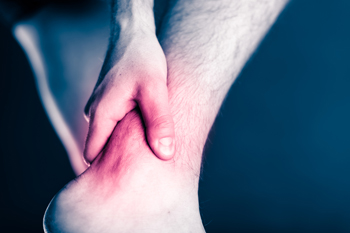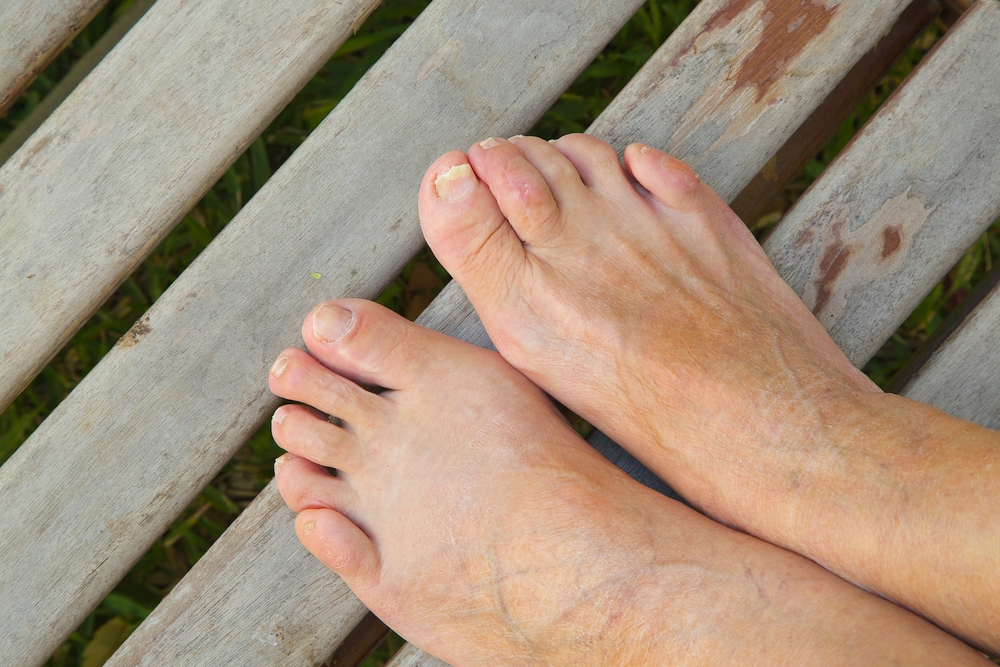
An ingrown toenail is easily distinguishable and is defined as a toenail that grows into the skin instead of over it. An ingrown toenail often causes severe pain and discomfort, and it can become infected. This foot condition can happen for a variety of reasons. Common causes can include wearing shoes that are too tight and trimming the toenails incorrectly. There are some patients who have family members with ingrown toenails, which may increase the risk of developing this ailment. Temporary relief may be found when the affected nail is soaked in warm water. This can soften the skin enough so that a small piece of cotton can be used while gently pulling the nail away from the skin. Permanent relief is often found with medical attention. If you have developed an ingrown toenail, it is strongly suggested that you seek the counsel of a podiatrist who can provide appropriate treatment options, which may include minor surgery.
Ingrown toenails may initially present themselves as a minor discomfort, but they may progress into an infection in the skin without proper treatment. For more information about ingrown toenails, contact one of our podiatrists of McKinney Podiatric Associates, PA. Our doctors can provide the care you need to keep you pain-free and on your feet.
Ingrown Toenails
Ingrown toenails are caused when the corner or side of a toenail grows into the soft flesh surrounding it. They often result in redness, swelling, pain, and in some cases, infection. This condition typically affects the big toe and may recur if it is not treated properly.
Causes
You are more likely to develop an ingrown toenail if you are obese, have diabetes, arthritis, or have any fungal infection in your nails. Additionally, people who have foot or toe deformities are at a higher risk of developing an ingrown toenail.
Symptoms
Some symptoms of ingrown toenails are redness, swelling, and pain. In rare cases, there may be a yellowish drainage coming from the nail.
Treatment
Ignoring an ingrown toenail can have serious complications. Infections of the nail border can progress to a deeper soft-tissue infection, which can then turn into a bone infection. You should always speak with your podiatrist if you suspect you have an ingrown toenail, especially if you have diabetes or poor circulation.
If you have any questions, please feel free to contact one of our offices located in Pasadena, Baytown, League City, Houston, and Pearland,TX . We offer the newest diagnostic and treatment technologies for all your foot care needs.

Active children and young teenagers may be prone to developing Sever’s disease. It is a condition that affects the growth plate in the heel and can cause severe pain and discomfort. The pain is felt in the heel, and one of the first signs parents may notice is their child is limping. Additionally, affected children may walk on their tiptoes to avoid putting pressure on the heel. The treatment for Sever’s disease can begin with temporarily stopping the activity that caused this condition, and frequently elevating the affected foot. It is beneficial to avoid walking on that foot, and it may help to wear a protective boot or to use crutches. Parents may find their children may benefit from practicing stretching techniques, which can help the heel and calf muscles. If your active child has heel pain, it is suggested that you schedule an appointment with a podiatrist who can effectively diagnose and treat Sever’s disease.
Sever's disease often occurs in children and teens. If your child is experiencing foot or ankle pain, see one of our podiatrists from McKinney Podiatric Associates, PA. Our doctors can treat your child’s foot and ankle needs.
Sever’s Disease
Sever’s disease is also known as calcaneal apophysitis, which is a medical condition that causes heel pain I none or both feet. The disease is known to affect children between the ages of 8 and 14.
Sever’s disease occurs when part of the child’s heel known as the growth plate (calcaneal epiphysis) is attached to the Achilles tendon. This area can suffer injury when the muscles and tendons of the growing foot do not keep pace with bone growth. Therefore, the constant pain which one experiences at the back of the heel will make the child unable to put any weight on the heel. The child is then forced to walk on their toes.
Symptoms
Acute pain – Pain associated with Sever’s disease is usually felt in the heel when the child engages in physical activity such as walking, jumping and or running.
Highly active – Children who are very active are among the most susceptible in experiencing Sever’s disease, because of the stress and tension placed on their feet.
If you have any questions, please feel free to contact one of our offices located in Pasadena, Baytown, League City, Houston, and Pearland,TX . We offer the newest diagnostic and treatment technologies for all your foot and ankle injuries.

A stiff and painful ankle is common after an ankle injury, such as an ankle sprain, fracture, or Achilles tendon tear. Stretching, mobilizing, and re-training can increase the mobility and functionality of the ankle. Patients are often put in a cast after an ankle injury, and while the immobilization helps with healing, it also creates swelling and inflammation. Dorsiflexion is important while walking and running, and occurs when the foot comes up towards the shin. This is one of the most frequent and limiting ranges of motion lost after an ankle problem. A quick, short-term option to relieve some of the stiffness is to wear shoes that have a heel or heel wedge. Longer term, it is suggested that you be under the care of a podiatrist who can help you with proper exercises and other relief options for stiff ankles.
Ankle pain can have many different causes and the pain may potentially be serious. If you have ankle pain, consult with one of our podiatrists from McKinney Podiatric Associates, PA. Our doctors will assess your condition and provide you with quality foot and ankle treatment.
Ankle pain is any condition that causes pain in the ankle. Due to the fact that the ankle consists of tendons, muscles, bones, and ligaments, ankle pain can come from a number of different conditions.
Causes
The most common causes of ankle pain include:
Symptoms
Symptoms of ankle injury vary based upon the condition. Pain may include general pain and discomfort, swelling, aching, redness, bruising, burning or stabbing sensations, and/or loss of sensation.
Diagnosis
Due to the wide variety of potential causes of ankle pain, podiatrists will utilize a number of different methods to properly diagnose ankle pain. This can include asking for personal and family medical histories and of any recent injuries. Further diagnosis may include sensation tests, a physical examination, and potentially x-rays or other imaging tests.
Treatment
Just as the range of causes varies widely, so do treatments. Some more common treatments are rest, ice packs, keeping pressure off the foot, orthotics and braces, medication for inflammation and pain, and surgery.
If you have any questions, please feel free to contact one of our offices located in Pasadena, Baytown, League City, Houston, and Pearland,TX . We offer the newest diagnostic and treatment technologies for all your foot care needs.

Hammertoe is a particular kind of affliction of the feet which primarily impacts the joints of the toes. An individual living with hammertoe will notice that the joint of their toe sticks up while the rest of the toe points downward. Many patients often confuse this condition with another known as claw toe. Claw toe is different and distinct from hammertoe in that patients with claw toe have unnatural bends in the last two joints of the toe. As a result, the entire toe curls downward. Therefore, hammertoe and claw toe create different shapes in the toes. If you are interested in preventing the onset of these different foot conditions, it is suggested that you contact a podiatrist immediately for any possible advice or treatment.
Hammertoe
Hammertoes can be a painful condition to live with. For more information, contact one of our podiatrists from McKinney Podiatric Associates, PA. Our doctors will answer any of your foot- and ankle-related questions.
Hammertoe is a foot deformity that affects the joints of the second, third, fourth, or fifth toes of your feet. It is a painful foot condition in which these toes curl and arch up, which can often lead to pain when wearing footwear.
Symptoms
Causes
Genetics – People who are genetically predisposed to hammertoe are often more susceptible
Arthritis – Because arthritis affects the joints in your toes, further deformities stemming from arthritis can occur
Trauma – Direct trauma to the toes could potentially lead to hammertoe
Ill-fitting shoes – Undue pressure on the front of the toes from ill-fitting shoes can potentially lead to the development of hammertoe
Treatment
Orthotics – Custom made inserts can be used to help relieve pressure placed on the toes and therefore relieve some of the pain associated with it
Medications – Oral medications such as anti-inflammatories or NSAIDs could be used to treat the pain and inflammation hammertoes causes. Injections of corticosteroids are also sometimes used
Surgery – In more severe cases where the hammertoes have become more rigid, foot surgery is a potential option
If you have any questions please contact one of our offices located in Pasadena, Baytown, League City, Houston, and Pearland,TX . We offer the newest diagnostic and treatment technologies for all your foot and ankle needs.